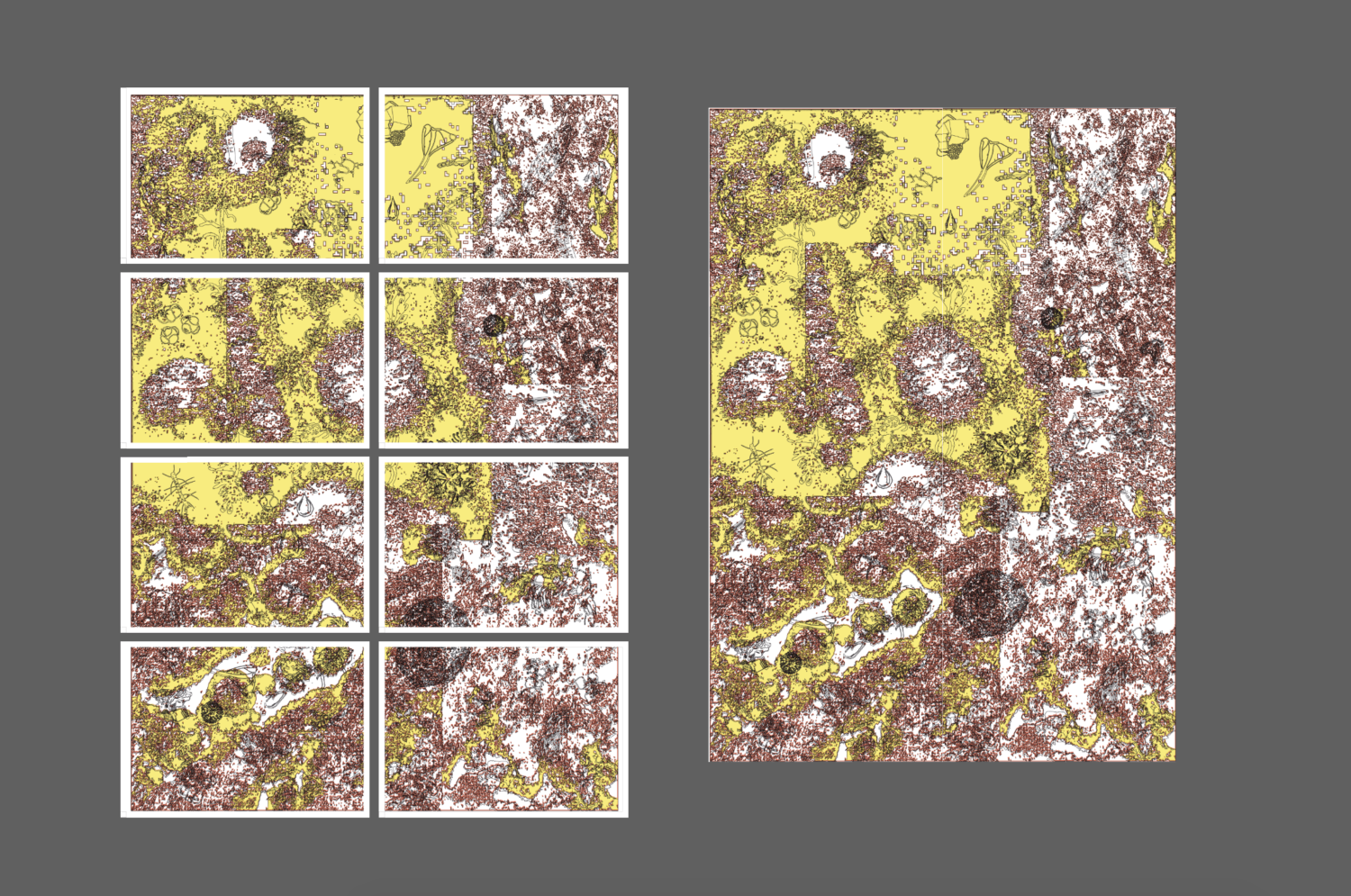Turberas Risographs by Rosario Ureta
Keywords: mob, diversity, layers, chaos, scale, wandering, glitch, fabric
Essays commissioned me to develop, in collaboration with Camila Marambio and Christy Gast, images that would represent the ecosystems of the peat bogs and that would be transformed into posters printed in risography for the Poster Portal project of the exhibition For there to be a party, you have to dance the forest, curated by Michy Marxuach in collaboration with multiple transhemispheric voices. One of these designs would also be the official poster for the Bi-national Seminar on Peatlands in Patagonia.
To imagine these spongy bodies that are peat bogs in 2D, it was first necessary to understand that they are ecosystems of great diversity, where chaotic encounters occur between all the layers and elements that compose them: microorganisms, gases, plants, invertebrates, litter.
Christy and Camila began sending me drawings of the many organisms and non-organisms that can be found scrambled within the peat. So the idea was to generate a background texture to compose the drawings on it, and that they would become entangled and confused until they formed a single plot. After receiving the drawings, I sent my processes to my collaborators, Christy, Camila, and the WCS scientists so that they could give me back their perceptions. A coming and going of ideas that was weaving a textile, like what peat bogs seem to be made of.
To design the background on which the drawings would go, I grouped several photos of peat bogs seen from above, giving a cartographic sensation, which interested me to talk about them as a territory, or a map. When composing them, I zoomed in on some parts and zoomed out on others. A game of scales, approaches and distances was produced that caused a glitch, a digital distortion of the image that reveals its pixels and its fragility to the support. This distortion of the image also worked as an analogy with these ecosystems, erratic in their composition and fragile to human intervention.
From the beginning these images were visualized to be printed in risography. There was a forced foot in terms of format and colors, in particular, because risography is printed in layers of color. In this way, the images were constructed taking into account the printing medium: by layers of color; a work that insisted on the idea of the formation of a fabric as a representation of the body of peat bogs.
Risografías Turberas por Rosario Ureta
Palabras Clave: turba, diversidad, capas, caos, escala, errante, glitch, tejido
Ensayos me hizo el encargo de desarrollar, en colaboración con Camila Marambio y Christy Gast, imágenes que representaran a los ecosistemas de las turberas y que se transformaran en afiches impresos en risografía para el proyecto Póster Portal de la exposición Para que haya fiesta tiene que danzar el bosque, curada por Michy Marxuach en colaboración con múltiples voces transhemisféricas. Uno de estos diseños además sería el afiche oficial del Seminario Bi-nacional de Turberas de Patagonia.
Para imaginar en 2D estos cuerpos esponjosos que son las turberas, fue necesario primero comprender que son ecosistemas de mucha diversidad, donde se producen encuentros caóticos entre todas las capas y elementos que las componen: microorganismos, gases, plantas, invertebrados, basuritas.
Christy y Camila comenzaron a mandarme dibujos de los muchos organismos y no-organismos que se pueden encontrar revueltos dentro de la turba. Entonces la idea fue generar una textura de fondo para componer sobre ella los dibujos, y que se fueran enredando y confundiendo hasta formar una sola trama. Luego de recibir los dibujos yo enviaba a mis colaboradoras, Christy, Camila, y las científicas de la WCS mis procesos para que ellas me devolvieran sus percepciones. Un ir y venir de ideas que fue entramando un textil, como del que parecen estar hechas las turberas.
Para diseñar el fondo sobre el cual irían los dibujos, agrupé varias fotos de turberas vistas desde arriba, dando una sensación cartográfica, lo cual me interesó para hablar de ellas como un territorio, o un mapa. Al componerlas, hice zoom en algunas partes y otras las alejé. Se produjo un juego de escalas, acercamientos y alejamientos que provocaron un glitch, una distorsión digital de la imagen que devela sus pixeles y su fragilidad al soporte. Esta deformación de la imagen también funcionó como una analogía con estos ecosistemas, erráticos en su composición y frágiles a la intervención humana.
Desde un principio se visualizaron estas imágenes para ser impresas en risografía. Había un pie forzado en cuanto al formato y los colores, en particular, porque la risografía se imprime por capas de color. De ese modo, las imágenes fueron construídas tomando en cuenta el medio de impresión: por capas de color; un trabajo que insistió en la idea de la formación de un tejido como representación del cuerpo de las turberas.


